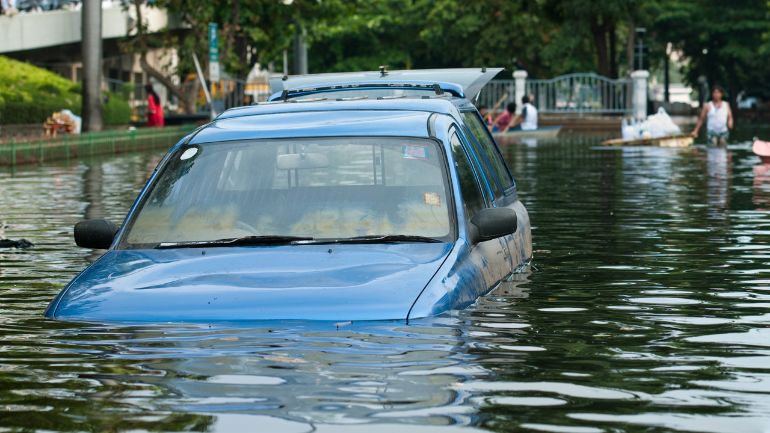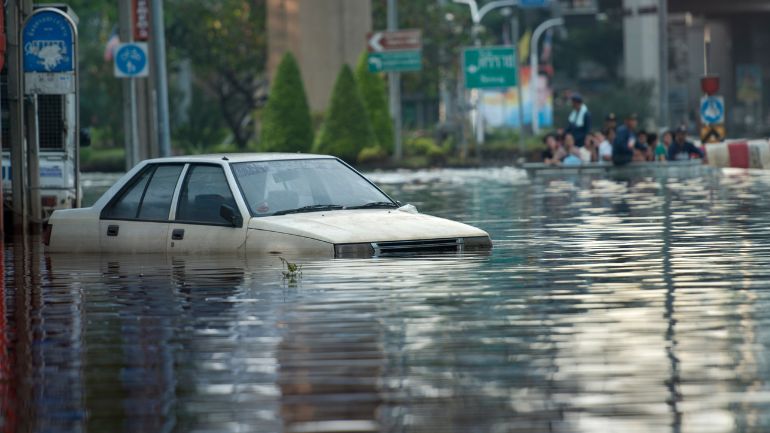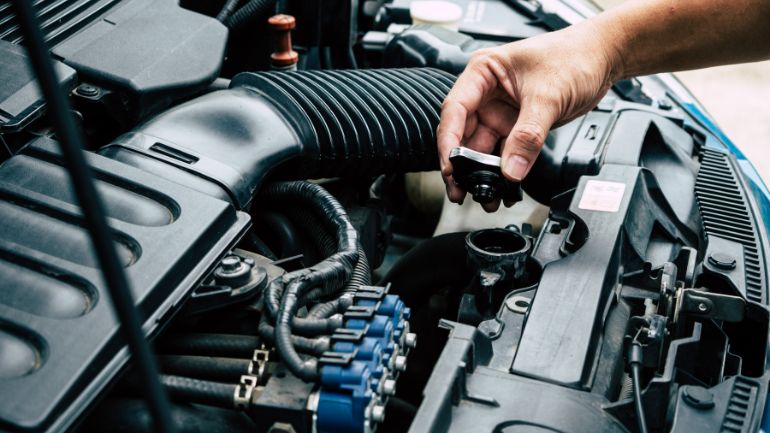It is unfortunate when motorists ignore “High Water” warnings. Motorists driving through floodwaters and massive downpours oftentimes experience the worst, a stalled vehicle. What to do if your car stalls in water? It depends on the circumstances, but for everyone’s safety, evacuating the vehicle is the best policy.
Once the engine stalls, there is no hope of getting the engine to turn over. This especially applies to a stalled vehicle surrounded by water.
Table of Contents
- How To Evacuate A Car Stalled In Water?
- NOAA Severe Weather Forecast
- How Much Standing Water Is Dangerous?
- How To Restart Car After Stalling In Water
- What Is A Hydrolocked Engine?
- What Happens To A Hydrolocked Engine?
- Is My Engine Hydrolocked?
- Can A Hydrolocked Engine Be Fixed?
- The Cost Of Fixing A Hydrolocked Engine
- Avoiding A Hydrolocked Engine
- Safety Tips For Driving In Flooded Areas
- What Needs To Be Changed In A Flooded Car?
- Frequently Asked Questions
How To Evacuate A Car Stalled In Water?

There are precautions that motorists need to be taken when found in a similar situation. One thing is for sure, drivers and their passengers should never emerge from a stalled vehicle in water before assessing their surroundings. Regardless, it is only possible to determine the water depth with the proper equipment that motorists generally do not store in their vehicles.
After a quick scan of the area, it is time to emerge from the vehicle. If the engine stalled, the electrical system has most likely malfunctioned. Most modern vehicles are equipped with power (electricity-powered) windows. Unless the window is already down, the occupants must open their doors, which is extremely risky.
Depending on the water current, it may be difficult to keep the door open. Someone may need to hold the door open with their foot until everyone has ascended to the roof. With this said, it is vital to take no chances in someone getting left behind to drown. Everyone should wait on the roof or hood of the vehicle until the rescue squad arrives.
NOAA Severe Weather Forecast
National Oceanic and Atmospheric Administration “NOAA,” a federal government agency, is responsible for monitoring atmospheric disturbances. NOAA forecasts thunderstorms, hurricanes, tropical storms, snow, sleet, hail, and high winds. Most weather outlets rely on NOAA forecasts to ensure their listeners are prepared for severe weather.
NOAA issues severe weather through radio and TV stations across the country. However, there is no guarantee everyone has access to the weather alerts. Unaware motorists are at risk of encountering dangerous weather conditions. NOAA weather alerts can save lives but only if motorists are tuned in.
How Much Standing Water Is Dangerous?
Motorists drive their vehicles on wet roads all the time without experiencing any issues. Water on roadways poses many dangers, including hydroplaning or skidding. Tires are designed with tread blocks that grip the surface of roads. Tread blocks offer substantial benefits:
- Improved fuel economy
- Improved traction
- Smoother acceleration
- Improved braking
- Smoother driving capability
New tire tread blocks measure between 10/32 and 11/32 inches in thickness. Less than half an inch thick, tread blocks lose traction in standing water. The average weight of a passenger car is 2,500 pounds. It only takes six inches of water on highways to pose hydroplaning risks. When tire tread blocks less than half an inch in thickness quickly pass over six inches of water, hydroplaning is a possibility.
It only takes six inches of standing water to stall a vehicle’s engine. Rushing water is even more dangerous. Two feet of water with swift currents can carry a 4,000-pound pickup truck off the roadway into deeper waters.
How To Restart Car After Stalling In Water

After you’ve stalled your vehicle in water, you’ll need to restart it as quickly as possible. Unfortunately, this may not be possible since the car’s components could be seriously damaged.
If you’re lucky, this isn’t the case and the car is still functional. Start by opening the hood and giving the engine time to dry.
While you wait, be sure to look at the other components to see if anything is wet. You may need to replace the spark plugs before trying to restart the car.
Once the engine has dried, try starting the vehicle. In the best case, the car will start and will continue running as normal.
Unfortunately, there is always a risk that the engine has been damaged or you’ve experienced a hydro lock. Therefore, the fix may not be so simple.
What Is A Hydrolocked Engine?
If you drive your vehicle through floodwaters, you’re likely going to experience a hydrolocked engine. Hydrolocking means that the engine has seized due to the ingestion of excess water in the engine’s cylinders.
It can also be caused by catastrophic failure. Regardless, hydrolocking is never good for you or your automobile.
Once you’ve experienced the signs of hydrolocking, it is vital to pull over and call a mechanic immediately. Hydrolocking is going to add extreme stress to the pistons, cylinders, oil seals, and crankshafts.
If you continue driving the vehicle, the chance of severe damage will be much higher. The pistons may end and the crankshaft may crack.
Do not continue driving the vehicle because this will cause the problem to worsen rapidly.
Unfortunately, you may have to replace the engine to resolve the problem.
What Happens To A Hydrolocked Engine?
Hydrolocking occurs when too much water has entered the cylinders. This is most common when someone attempts to drive through high waters.
It can cause the engine to seize or fail. Furthermore, hydrolocking will severely damage the internal components of the engine.
For instance, the excess water will place significant stress on the pistons and crankshaft. If the engine continues running, the pistons are going to bend and the crankshaft may develop cracks.
The cylinder walls and oil seal may also be damaged. While hydrolocked engines are primarily caused by floodwaters, they can also be caused by coolant leaks.
A head gasket lead may result in a coolant leak allowing the coolant to enter the cylinders.
Is My Engine Hydrolocked?
It usually isn’t difficult to know when your engine has become hydrolocked. After all, you’ve likely just driven through floodwaters.
There are other signs that can tell you that you’re dealing with a hydrolocked engine. For instance, the vehicle is going to run rough.
This will continue for a few seconds as water enters the cylinder. Then, you’ll start heading a knocking sound. Before you know it, you’ll hear a loud thud and the engine will stop.
If you’ve encountered these things, you’re probably dealing with a hydrolocked engine. Do not attempt to start or drive the car.
Park in a safe spot and call for assistance.
Can A Hydrolocked Engine Be Fixed?
Depending on the severity of the problem, it may be possible to fix a hydrolocked engine. Unfortunately, most engine repairs are very expensive. The same can be said for a hydrolocked engine.
If the problem is minor, you can probably fix it easily. Otherwise, you may be better off replacing the entire engine or buying a new car.
Try the advice below before giving up though.
Fixing A Minor Hydrolocked Engine
You better hope that the problem is minor. For instance, water might’ve damaged one of your sparkplugs. Thankfully, this will be very easy to resolve.
You’ll just need to remove the wet sparkplug and replace it. It is also a good idea to dry the other components.
Alternatively, you may need to change the oil and replace the filters. If the vehicle was submerged for a long period, the damage is probably more severe.
Start with an extensive inspection so you can find out which components were damaged.
Steps For Fixing A Hydrolocked Engine

It can be hard to fix a severely hydrolocked engine, but it still may be possible. When you’re ready to begin, start by draining water from the engine cylinders.
Whether you’re dealing with water or coolant, the fluid must be completely drained from the cylinders. Then, you will need to begin dismantling the engine and separating the components.
Carefully inspect each component to see whether it has been damaged. Depending on the situation, you may need to replace bearings, cylinders, or pistons.
Any damaged or faulty parts must be replaced. Begin reassembling the parts.
Once the engine is reassembled, use pressure tests to ensure that everything is working properly. If you’re dealing with many damaged parts, it may be cheaper and easier to replace the entire engine.
The Cost Of Fixing A Hydrolocked Engine
Hydrolocked engines can be difficult to repair. As a result, the costs are going to be very high. You’re going to spend a few thousand dollars at the minimum to fix this problem.
The repair will be meticulous so the labor costs are expensive too. At the minimum, you’ll pay roughly $3,000 to fix minor damage.
However, you may end up paying as much as $10,000 to fix the problem. The final cost will depend on the mechanic, your location, and the severity of the damage.
Avoiding A Hydrolocked Engine
At the end of the day, it is best to never experience a hydrolocked engine. You likely depend on your vehicle each day and can’t reach work without it.
To avoid a headache and heartbreak, try to protect your engine by staying away from floodwaters.
In some cases, it’ll be impossible to avoid hydrolocking because floodwaters can raise quickly. If you find yourself in the middle of a flash flood, you might not be able to avoid this problem.
Nevertheless, there are ways to minimize the risks. For starters, you should try to keep water away from your engine.
Prevent water from entering the air filter or intake. If you’re washing your car, be sure to keep the hood shut.
When your city floods, it is best to stay home. You may be required to drive somewhere though. Be sure to avoid floodwaters.
Once you suspect water has entered your engine, turn off the car and seek professional help. If you continue driving the vehicle, you’re likely going to encounter the symptoms of hydrolocking and the damage will intensify.
Dealing with the problem sooner may minimize the damage done to the engine.
Safety Tips For Driving In Flooded Areas
When your city floods, it is best to stay where you are. Even if you’re stuck at work, it is safer to stay put than trying to drive home. Otherwise, you may get stuck in floodwaters.
You should always avoid driving into flooded areas because the risks are immense. Even if you make it to the other side, your vehicle could be damaged.
However, the floodwaters could rise around your car in a matter of seconds. If this happens, you’re going to find yourself in a life-threatening situation.
If your car gets stuck in floodwaters, get out and reach higher ground immediately. Don’t wait in the vehicle because the swift waters can sweep it away rapidly.
Two feet of water is enough to carry a vehicle. Never drive through six or more inches of water because this is enough to damage the engine and other components.
When necessary, climb onto your hood and wait for help. If you see flooded roads, turn around to avoid risky situations.
What Needs To Be Changed In A Flooded Car?
Many components must be changed in a flooded car. In many cases, you’ll have to change the engine or have it repaired.
You’ll also want to check the interior, oil dipstick, and filters. The oils, fluids, and filters should be changed.
Certain electrical components will likely need to be changed. Be sure to check the gas tank and fuel line because they may contain water.
Frequently Asked Questions
Does Insurance Cover Hydrolocking?
In some cases, your insurance will offer coverage for hydrolocking. It depends on whether your insurance covers flood damage. However, you must remember that your insurance company won’t cover damages caused by negligence.
Is It Worth It To Repair A Hydrolocked Engine?
It may be worth trying to repair your hydrolocked engine. In some situations, the problem is minor so you can fix the issue easily. On the other hand, the damage may be severe.
If you’re dealing with a severe hydrolock, it is probably cheaper to replace the engine instead of trying to repair it.
How Much Water Is Too Much?
When driving in flooded areas, it is pertinent to avoid deep waters because they will destroy your vehicle. Passenger vehicles should never be driven through six or more inches of water.
Taller vehicles can probably drive through deeper water, but it is best to avoid driving through any puddles.

Robert Bacon is a car nerd and automotive lover who has dedicated his life to understanding the inner workings of vehicles. He holds a degree in mechanical engineering and has spent years working as a mechanic and engineer for some of the world’s top car companies. In his spare time, he enjoys writing about cars on this blog and tinkering with his 2016 Toyota Mirai in his garage.